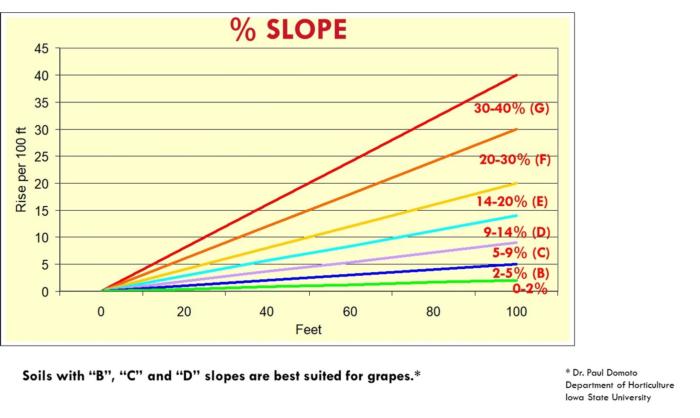Location

Location
- Location is important to have healthy, producing vines which thrive over many years.
- Sufficient sunlight is important to ensure proper ripening of grapes and prevention of diseases.
- Frost during sensitive growing time (spring).
- Areas to consider when selecting site
- Elevation, including sea level and variation in elevation within the site
- Slope, or the degree of inclination of the land (% slope)
- Aspect (north, south, east, or west)
- History of the site, including previous crops/vegetation, chemicals, weeds and diseases
Location - elevation
- Elevation refers to either the elevation within a certain location (high point vs. low point) or to the absolute elevation (feet above sea level).
- Planting a vineyard on or near the highest point on any given location will promote better air and water drainage.
- Air drainage is essential in frost and freeze events.
- Cold air is heavier than warm air, so it settles in areas of low elevation.
- Water drainage is also important because standing water will limit the oxygen available to the vine root system.
Location - slope
- The slope of a site refers to the degree of inclination of the land.
- A slight to moderate slope can be beneficial because it accelerates cold air drainage.
- Generally, the steeper the slope, the faster cold air moves downhill, if there are no barriers to air movement such as trees or berms.
- Air drainage is important for protection against spring frosts.
- Vegetation that slows or stops air drainage should be removed during site preparation because it can act as a dam and force cold air back up the slope.
- Steep slopes can create issues manipulating machinery.
- Soil erosion is increased on steep slopes.
- Slopes with greater than approximately 15 percent (a 15-foot drop in elevation for each 100-foot horizontal displacement) should be avoided.
Location - aspect
- The aspect of a slope refers to the compass direction the slope faces (north, south, east, or west).
- Depending on the climate of your region, different slopes should be selected for the greatest benefit of vineyard production.
- In cool climates where summers are cool and growing degree days are low, northern slopes should be avoided and southern slopes (S, SE and SW) are preferred to allow maximum heat accumulation on that site to grow and ripen grapes.
- In climates with warm or hot summers and cold winters, eastern, northern, and northeastern slopes are preferred over southern and western exposures
- Southern and western exposures are warmer than eastern and northern exposures.
- Southern exposures warm earlier in the spring and can slightly advance bud break, thus increasing potential for frost damage.
- Eastern aspects have an advantage over western aspects because eastern slopes are exposed to morning sun.
- Vines on an eastern slope will dry (from dew or rain) sooner than those on a western slope, potentially reducing disease risk.
- In regions with warm growing and lower humidity conditions, growers may want to avoid fully west facing slopes or make changes in row orientation to reduce over-heating the fruit.
- Grapevine is a plant of warm climate: it requires a sufficient amount of heat for the growth. Its development is strongly influenced by daily temperature.
- Understanding the growing degree days (gdd) is critical to understanding numerous key parameters:
- Vine growth stages
- Selection of varieties
- pest development
- Timing to apply fertilizer
- Heat stress
